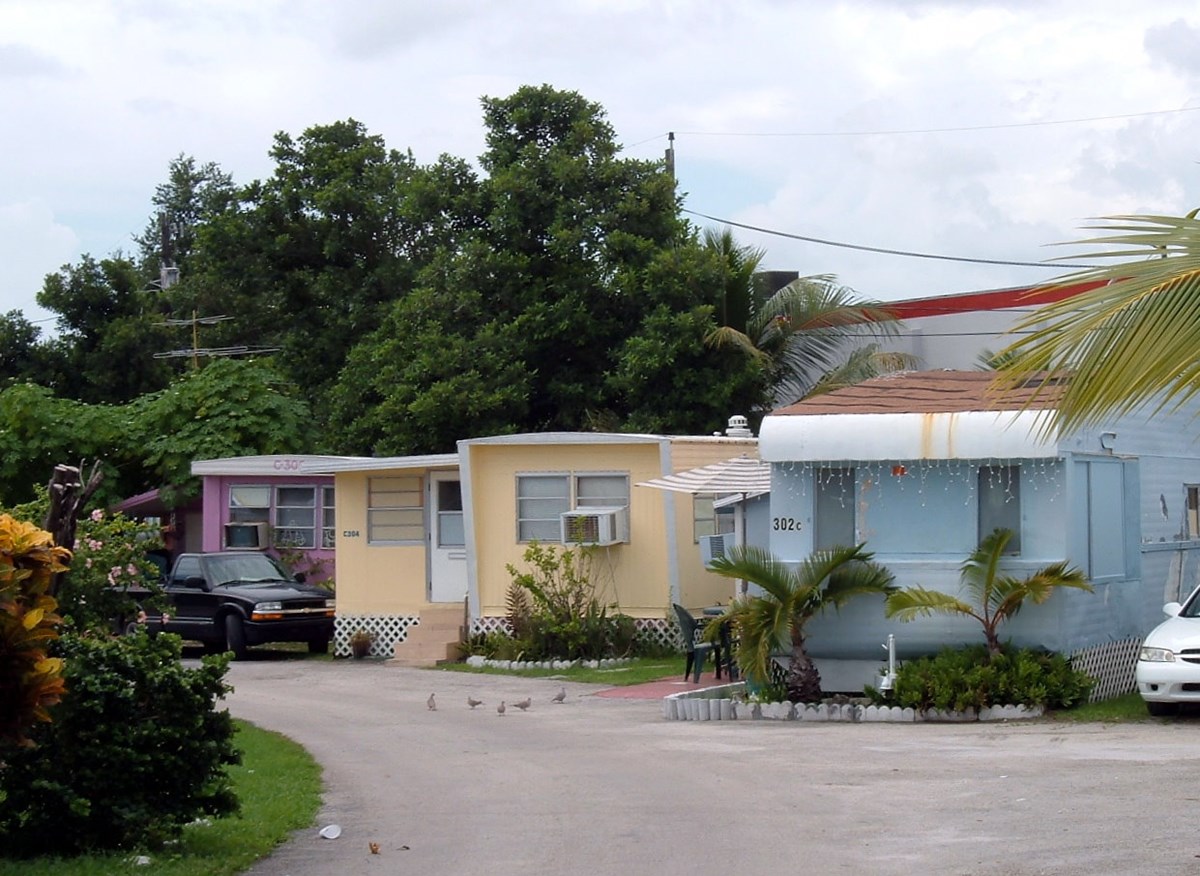Given that “redneck” and “hillbilly” remain the last acceptable stereotypes among polite society, it isn’t surprising that the stereotypical urban home of poor, recently rural whites remains an object of scorn. The mere mention of a trailer park conjures images of criminals in wifebeaters, moldy mattresses thrown awry, and Confederate flags.
As with most social phenomena, there is a much more interesting reality behind this crass cliché. Trailer parks remain one of the last forms of housing in US cities provided by the market explicitly for low-income residents. Better still, they offer a working example of traditional urban design elements and private governance.
Any discussion of trailer parks should start with the fact that most forms of low-income housing have been criminalized in nearly every major US city. Beginning in the 1920s, urban policymakers and planners started banning what they deemed as low-quality housing, including boarding houses, residential hotels, and low-quality apartments.
Meanwhile, on the outer edges of many cities, urban policymakers undertook a policy of “mass eviction and demolition” of low-quality housing. Policymakers established bans on suburban shantytowns and self-built housing.
In knocking out the bottom rung of urbanization, this ended the natural “filtering up” of cities as they expanded outward, replaced as we now know by static subdivisions of middle-class, single-family houses. The Housing Act of 1937 formalized this war on “slums” at the federal level and by the 1960s much of the emergent low-income urbanism in and around many U.S. cities was eliminated.
With prosperous cities increasingly turning into playgrounds of the rich due to onerous housing supply restrictions, we shouldn’t take these startlingly affordable rents lightly.
In light of the United States’ century-long war on low-income housing, it’s something of a miracle that trailer parks survive. With an aftermarket trailer, trailer payments and park rent combined average around the remarkably low rents of $300 to $500. Even the typical new manufactured home, with combined trailer payments and park rent, costs around $700 to $1,000 a month. Both options offer a decent standard of living at far less than rents for apartments of comparable size in many cities.
The savings with manufactured housing are a big part of the story: where the average manufactured house costs $64,000, the average site-built single-family house now costs $324,000.
The savings don’t come out of shoddy construction either: manufactured homes are increasingly energy efficient, and their manufacturing process produces less waste than traditional site-built construction. With prosperous cities increasingly turning into playgrounds of the rich due to onerous housing supply restrictions, we shouldn’t take these startlingly affordable rents lightly.
Trailer parks are not only cheap due to manufacturing; they’re also cheap thanks to their surprising exemption from most conventional land-use controls. Most cities zone very little space for trailer parks—presumably a reflection of the general bias against low-income housing. But where they exist, they are often subject to uniquely liberal land-use regulation, with minimal setbacks, fewer parking requirements, and tiny minimum lot sizes. The result is that many trailer parks have relatively high population densities.
The New World Economics blog explains:
If you had 70% home plots/15% roads/15% shared amenities like parks and squares, 1000sf plots, and 2.5 people per household, that works out to population density of 46,000 people per square mile — with one or two story construction! At this level of density, compared to about 9,000/mile for the denser Los Angeles suburb, you could easily have a lot of neat commercial stuff (bars, restaurants, shops, schools, etc.) within walking distance.
By combining these liberal land-use regulations with narrow streets shared by all users, we ironically find in many trailer parks a kind of traditional urban design more common in European and Japanese cities. With functional urban densities and traditional urban design, the only thing missing in most trailer parks is a natural mixture of commercial and industrial uses. Many urban trailer parks likely bypass this zoning-imposed challenge by locating within walking distance of commercial and industrial uses.
Besides revealing a natural acceptance of traditional urban design, trailer parks also illustrate the capacity for low-income communities to engage in private governance. Compared to many low-income neighborhoods, trailer parks are often fairly clean and relatively safe.
How could this be? The answer lies in the exchange at the heart of a trailer park: a trailer owner pays rent not only for a slice of land in an apparently desirable location but also for a kind of club good known as “private governance.” Edward Stringham describes the concept as “the various forms of private enforcement, self-governance, or self-regulation among private groups or individuals that fill a void that government enforcement cannot.”
The park management provides order within the park, upholding certain basic standards on cleanliness and maintenance while also dealing with unwanted visitors and settling disputes among neighbors.
Although costly to move, the mobile nature of the homes allows residents to shop around for governance amenities, punishing incompetent park managers by leaving and rewarding competent park managers by moving in. Residents can shop around for other lifestyle preferences, including parks restricted to retirees or parks managed to be family friendly.
we should extend the liberal land-use regulations common in trailer parks to site-built homes and apartments. Besides needlessly restricting the housing supply, conventional land-use restrictions undermine the traditional urban development.
While many see the purported incompetence of low-income families as a justification for paternalistic policies—including the above mentioned bans on low-quality housing—the success of private governance in trailer parks speaks to the potential of emergent social orders to address shared ills.
The lesson here is not, of course, that we should all go live in trailer parks. As a Kentuckian, I have spent enough time in and around trailers to think better of that idea. But here are three key lessons:
First, urban policymakers and planners must take a more permissive approach to low-quality, affordable housing options like trailer parks. Many cities tightly restrict the location and size of trailer parks, effectively limiting the choices of low-income families and undermining access to affordable housing.
Second, we should extend the liberal land-use regulations common in trailer parks to site-built homes and apartments. Besides needlessly restricting the housing supply, conventional land-use restrictions undermine the traditional urban development.
Finally, we should respect the complex orders that organize urban life, orders often visible only to members of the community. Where policymakers deem top-down regulation necessary, it should be designed to support rather than replace emergent orders that low-income communities have developed over time.
When we stop treating low-income communities as objects of scorn, to be subjected to top-down, paternalistic planning, we might find that we have a lot to learn from them.
This article has been reprinted with permission from Market Urbanism.

